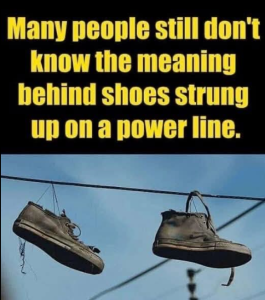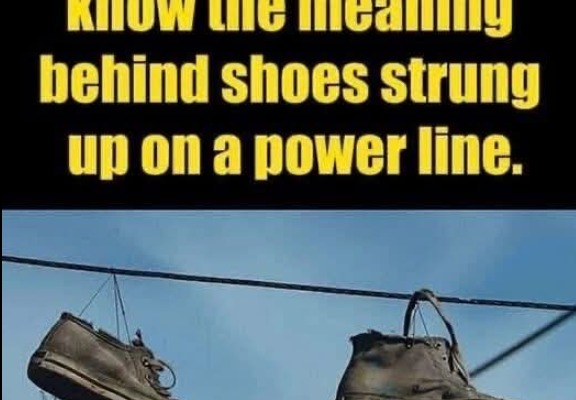The Meaning Behind Shoes Strung Up on a Power Line: A Tangle of Myth, Memory, and Message
You’ve seen them before—sneakers, boots, or high-tops tied together by their laces and flung over power lines, swaying like forgotten pendulums above the street. It’s a sight that feels both ordinary and mysterious, a visual riddle suspended in plain view. But what does it mean?
The truth is, shoes strung up on power lines carry no single, universal meaning. Instead, they form a patchwork of interpretations—some celebratory, some sinister, some deeply personal. Like graffiti or street murals, they speak in the language of urban folklore, coded messages, and cultural memory.
Let’s unravel the threads.
🧒 Childhood Pranks and Coming-of-Age Rituals
In many neighborhoods, especially in the U.S., tossing shoes over power lines is a rite of passage. Teenagers might do it to mark the end of a school year, a graduation, or simply as a prank. The act itself—tying the laces, winding up, and launching the shoes skyward—is a kind of rebellion, a moment of defiance against gravity and authority.
Some say it’s a way of saying goodbye to childhood. Others claim it’s done to commemorate a first kiss, a lost bet, or a dare. In this context, the shoes become a time capsule—a symbol of youth suspended in the air.
🕊️ Memorials and Mourning
In more somber cases, shoes on power lines serve as memorials. When someone dies—especially suddenly or violently—friends and family may toss their shoes overhead as a tribute. It’s a way of saying, “They were here. They mattered.”
This practice is especially common in communities where formal memorials are rare or inaccessible. The shoes become a public marker of grief, a silent vigil that hangs above the street. Sometimes, they’re accompanied by candles, photos, or graffiti bearing the person’s name.
In these moments, the shoes are not just objects—they’re elegies.
🧠 Urban Legends and Gang Symbolism
One of the most persistent theories is that shoes on power lines mark gang territory or drug-dealing zones. In some cities, this belief is widespread, and residents may interpret the shoes as a warning or a signal.
However, law enforcement agencies have largely debunked this idea. While it may hold true in isolated cases, there’s no consistent evidence that gangs use shoes as territorial markers. Still, the myth persists—perhaps because it taps into deeper fears about safety, control, and the unseen rules of the street.
In this context, the shoes become symbols of danger, whispered codes in the urban landscape.
🎨 Street Art and Social Commentary
For some, shoe tossing is a form of street art. Like Banksy’s stencils or Shepard Fairey’s posters, the shoes are meant to provoke thought, challenge norms, or beautify neglected spaces.
Artists may use shoes to comment on consumerism, identity, or displacement. A pair of designer sneakers dangling above a rundown block might critique wealth inequality. A row of children’s shoes could evoke themes of innocence or loss.
In these cases, the shoes are intentional, curated, and symbolic. They’re not just thrown—they’re placed.
🥾 Military Traditions and Cultural Customs
The act of tossing shoes isn’t limited to power lines—or even to modern times. In military culture, it’s common to throw boots over a wire or tree branch to mark the end of service. It’s a way of saying, “I’m done. I’m going home.”
Similarly, in some wedding traditions, shoes are thrown to bless the couple or ward off evil spirits. In ancient England, guests would hurl shoes at newlyweds for good luck. In space history, astronauts reportedly tossed their moon boots before reentry as a symbolic gesture.
These customs suggest that shoe tossing can be celebratory, ritualistic, and deeply rooted in tradition.
🧦 Bullying and Displacement
Not all shoe tosses are voluntary. In some cases, bullies steal shoes from their victims and throw them onto power lines as a form of humiliation. The shoes become unreachable, mocking reminders of vulnerability.
This interpretation is especially poignant in marginalized communities, where the shoes may represent not just bullying, but displacement, poverty, or exclusion. A pair of worn sneakers overhead might tell a story of someone who was pushed out, forgotten, or silenced.
Here, the shoes are not symbols—they’re scars.
🌀 The Psychology of Repetition
Sometimes, shoes end up on power lines simply because others are already there. It’s a phenomenon known as “monkey see, monkey do.” One pair becomes two, then ten, then a whole row. The original meaning may be lost, but the act continues.
This kind of repetition speaks to our human need for connection, mimicry, and ritual. We see something strange, and we want to be part of it. We add our shoes to the line, not knowing why—but knowing it matters.
In this sense, the shoes become a collective mystery, a shared question hanging in the sky.
⚡ The Danger Behind the Symbol
While the meanings may vary, one thing is clear: throwing shoes onto power lines is dangerous. It can damage electrical infrastructure, cause outages, and pose risks to utility workers. In some areas, it’s considered vandalism and can result in fines or legal action.
Despite this, the practice persists—perhaps because it’s so deeply woven into the fabric of urban life. The shoes are more than litter. They’re messages, memories, and metaphors.
🌍 A Global Phenomenon
From New York to Nairobi, Sydney to São Paulo, shoes on power lines appear in cities around the world. Each place adds its own layer of meaning, shaped by culture, history, and local lore.
In some neighborhoods, they’re seen as art. In others, as warnings. In still others, as jokes or games. The shoes speak in many tongues, but they all ask the same question: What are we trying to say?
🧵 Conclusion: Threads in the Sky
Shoes strung up on power lines are more than just footwear—they’re stories. They tell of joy and grief, rebellion and remembrance, art and accident. They hang above us like punctuation marks in the urban sentence, inviting us to look up and wonder.
So the next time you see a pair of shoes swaying in the wind, don’t just walk past. Ask yourself: Who threw them? Why? What message were they trying to send?
Because sometimes, the most powerful stories aren’t written on walls or whispered in alleys—they’re tied together by laces and left to dance in the sky.


